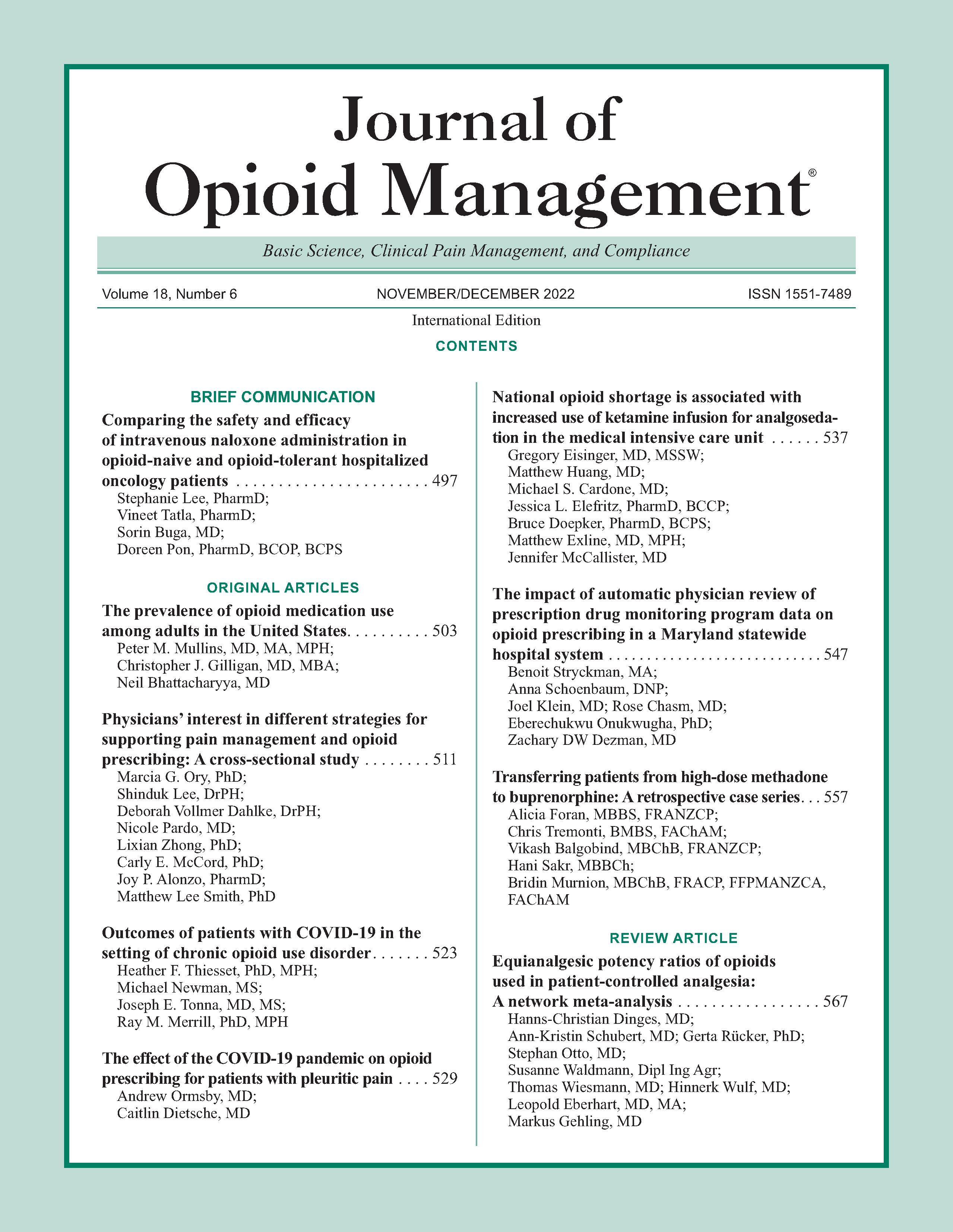Comparing the safety and efficacy of intravenous naloxone administration in opioid-naive and opioid-tolerant hospitalized oncology patients
DOI:
https://doi.org/10.5055/jom.2022.0744Keywords:
naloxone, naloxone dosing, respiratory depression, OWSs, chronic opioid useAbstract
Objective: To compare naloxone doses and clinical outcomes after emergency opioid reversal in opioid-naïve and opioid-tolerant inpatients.
Design: Cross-sectional, retrospective chart review.
Setting: Comprehensive cancer center.
Patients: In-patients who received ≥1 dose of intravenous naloxone for emergency opioid reversal between 2014 and 2018.
Methods: Patients were classified as opioid-tolerant based on opioid dosing history ≥60 morphine milligram equivalents/day for ≥7 consecutive days prior to naloxone administration. Response to naloxone was based on documentation of improvement in respiratory rate to >10 breaths/min or improved response to stimuli.
Outcomes: Naloxone doses and clinical outcomes after naloxone administration.
Results: Ninety-three naloxone episodes (58 opioid-naive and 35 opioid-tolerant) in 80 unique patients were included. No differences between opioid-naïve and opioid-tolerant groups were found for naloxone mean starting doses (0.14 mg vs 0.19 mg, p = 0.35), total doses (0.50 mg vs 0.32 mg, p = 0.07), and response rates (74.1 percent vs 77.1 percent, p = 0.81). Naloxone adverse reactions were more frequent in the opioid-tolerant group than the opioid-naïve group (opioid withdrawal symptoms (OWSs): 14.3 percent vs 0 percent; increase in pain: 20 percent vs 8.6 percent, p = 0.002).
Conclusions: In opioid-tolerant patients, naloxone total doses required and response rates were similar to opioid-naïve patients. Use of opioid dosing history to identify potentially opioid-dependent patients should be considered prior to naloxone administration to guide dosing and reduce the risk for precipitating OWSs.
References
van den Beuken-van Everdingen MHJ, Hochstenbach LMJ, Joosten EAJ, et al.: Update on prevalence of pain in patients with cancer: Systematic review and meta-analysis. J Pain Symptom Manage. 2016; 51(6): 1070-1090.e9. DOI: 10.1016/j.jpainsymman.2015.12.340.
Wesson DR, Ling W: The clinical opiate withdrawal scale (COWS). J Psychoactive Drugs. 2003; 35(2): 253-259. DOI: 10.1080/02791072.2003.10400007.
Kim HK, Nelson LS: Reducing the harm of opioid overdose with the safe use of naloxone: A pharmacologic review. Expert Opin Drug Saf. 2015; 14(7): 1137-1146. DOI: 10.1517/14740338.2015.1037274.
Connors NJ, Nelson LS: The evolution of recommended naloxone dosing for opioid overdose by medical specialty. J Med Toxicol. 2016; 12(3): 276-281. DOI: 10.1007/s13181-016-0559-3.
Hospira, Inc.: Naloxone hydrochloride injection, solution [package insert]. 2019. Available at https://dailymed.nlm.nih.gov/dailymed/drugInfo.cfm?setid=8535cc84-ad4a-4d67-8480-fb5a2e3406f8. Accessed August 23, 2021.
National Comprehensive Cancer Network: Referenced with permission from the NCCN Guidelines® for Adult Cancer Pain V.2.2021 © National Comprehensive Cancer Network, Inc. All rights reserved. NCCN makes no warranties of any kind whatsoever regarding their content, use or application and disclaims any responsibility for their application or use in any way. 2021. Available at www.NCCN.org. Accessed August 23, 2021.
Centers for Disease Control and Prevention: Calculating total daily dose of opioids for safer dosage. Available at https://www.cdc.gov/drugoverdose/pdf/calculating_total_daily_dose-a.pdf. Accessed August 26, 2021.
Janssen Pharmaceutical Companies: Duragesic (fentanyl system)-fentanyl patch [package insert]. 2021. Available at https://dailymed.nlm.nih.gov/dailymed/drugInfo.cfm?setid=4c3a6171-19e4-40c2-83f3-fb54d4736e4b. Accessed August 23, 2021.
Facey C, Brooks D, Boland JW: Assessment of the appropriateness of naloxone administration to patients receiving long-term opioid therapy. Hosp Pract. 2016; 44(2): 86-91. DOI: 10.1080/21548331.2016.1149016.
Gunasekaran B, Weil J, Whelan T, et al.: Assessment of potential opioid toxicity and response to naloxone by rapid response teams at an urban Melbourne hospital. Intern Med J. 2018; 48(2): 198-200. DOI: 10.1111/imj.13692.
Yung L, Lee KC, Hsu C, et al.: Patterns of naloxone use in hospitalized patients. Postgrad Med. 2017; 129(1): 40-45. DOI: 10.1080/00325481.2017.1263139.
Boland J, Boland E, Brooks D: Importance of the correct diagnosis of opioid-induced respiratory depression in adult cancer patients and titration of naloxone. Clin Med. 2013; 13(2): 149-151. DOI: 10.7861/clinmedicine.13-2-149.
Khosravi N, Zamani N, Hassanian-Moghaddam H, et al.: Comparison of two naloxone regimens in opioid-dependent methadone-overdosed patients: A clinical trial study. Curr Clin Pharmacol. 2017; 12(4): 259-265. DOI: 10.2174/1574884713666171212112540.
Purssell R, Godwin J, Moe J, et al.: Comparison of rates of opioid withdrawal symptoms and reversal of opioid toxicity in patients treated with two naloxone dosing regimens: A retrospective cohort study. Clin Toxicol. 2021; 59(1): 38-46. DOI: 10.1080/15563650.2020.1758325.
Kim HK, Nelson LS: Reversal of opioid-induced ventilator depression using low-dose naloxone (0.04 mg): A case series. J Med Toxicol. 2016; 12(1): 107-110. DOI: 10.1007/s13181-015-0499-3.
Published
How to Cite
Issue
Section
License
Copyright 2005-2025, Weston Medical Publishing, LLC and Journal of Opioid Management. All Rights Reserved.











